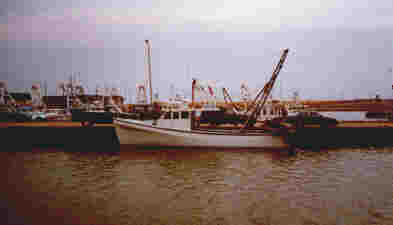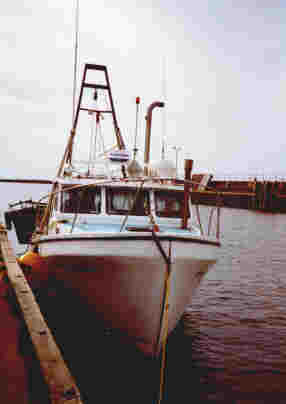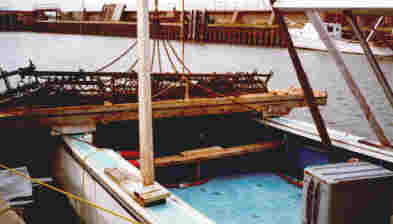Man overboard
scallop dragger "THE PAMELA & JENELLE L."
Northumberland Strait, Prince Edward Island
The Transportation Safety Board of Canada (TSB) investigated this occurrence for the purpose of advancing transportation safety. It is not the function of the Board to assign fault or determine civil or criminal liability. This report is not created for use in the context of legal, disciplinary or other proceedings. See Ownership and use of content. Masculine pronouns and position titles may be used to signify all genders to comply with the Canadian Transportation Accident Investigation and Safety Board Act (S.C. 1989, c. 3).
Summary
"THE PAMELA & JENELLE L." was engaged in a routine scallop harvesting trip. While harvesting in moderate to rough seas, the scallop rake snagged on the sea-bed; the vessel came to a sudden stop and rolled heavily. The propulsion was stopped and the deck-hand, who had been standing on the open afterdeck, was seen floating in the sea. Rescue attempts were unsuccessful, and he remains missing, presumed drowned.
The Board determined that the deck-hand lost his balance and fell overboard in moderate seas most probably because of the disruption in the vessel's motion due to the rake snagging on the sea-bed. Rescue attempts were hampered by the absence of a line attachment to the lifebuoy; the deck-hand was subsequently lost because he was not wearing any form of a flotation device.
1.0 Factual Information
1.1 Particulars of the Vessel
| "THE PAMELA & JENELLE L." | |
|---|---|
| Official number | 813780 |
| Port of registry | Charlottetown, P.E.I.Footnote 1 |
| Flag | Canadian |
| Type | Small fishing vessel (scallop dragger) |
| Gross TonsFootnote 2 | 15.60 |
| Length (registered) | 11.67 m |
| Built | 1990, Kensington, P.E.I. |
| Propulsion | Diesel engine, 400 BHP |
| Owner/Operator | Daniel G. London Montague, P.E.I. |
1.1.1 Description of the Vessel
"THE PAMELA & JENELLE L." is of open construction with the wheel-house positioned forward. It was built and rigged specifically for scallop harvesting (see Appendix A - photographs). All the fishing operations and stowage of the catch take place on the open afterdeck. There is an 81 cm-high bulwark at the perimeter of the deck which gives a 91 cm-high freeboard.
1.1.2 Description of Scallop Harvesting
Scallops are harvested by deploying a rake which consists of a toothed metal frame with a chain mesh bag attached. When towed along the sea-bed, the catch is raked into the mesh bag. In this instance, the rake was hauled on board at intervals of approximately five minutes and the scallops retrieved and processed (shucked) during the following tow.
1.2 History of the Voyage
"THE PAMELA & JENELLE L." departed Wood Islands Harbour, on the south coast of Prince Edward Island, at 0645Footnote 3, 29 October 1993, on a routine day trip. The crew of two comprised the owner/operator and a deck-hand. They commenced harvesting scallops on reaching the fishing grounds offshore. The vessel was rolling and pitching moderately in moderate to rough seas and strong north-westerly winds.
During fishing operations, the operator navigated from the wheel-house and operated the winch (used for hauling in the rake) from a position immediately abaft the wheel-house. The deck-hand was on the afterdeck sorting the catch and shucking the scallops during tows.
After harvesting for about 30 minutes, in position 45°54′ N, 62°54.3′ W, and heading in a westerly direction while towing the rake at a speed of some 2.5 knots, the rake snagged on the sea-bed, and the vessel suddenly stopped. This, in conjunction with the effects of the sea, caused the vessel to suddenly roll and list heavily to starboard. At that time, the operator was attending to the navigation in the wheel-house and the deck-hand had last been seen standing on the afterdeck holding a can of mineral water in one hand.
When the vessel stopped, the operator immediately disengaged the engine which, together with the weight of the rake warp and the effect of the wind, caused the vessel to move astern, back toward the rake. It was at that time that the operator saw the deck-hand in the sea about 15 m from the starboard bow, apparently attempting to swim or tread water.
1.3 Rescue Efforts
Upon sighting the deck-hand in the water, the operator threw the lifebuoy which fell close to the deck-hand; however, he was unable to reach it and it floated away.
The operator then slacked the rake warp, manoeuvred the vessel alongside the deck-hand and managed to hook on to his jacket with a gaff. The deck-hand was too heavy to lift on board over the bulwark and too weak to fully help himself. While holding the deck-hand with the gaff, the operator managed to reach through the wheel-house doorway and transmit a distress message by very high frequency radiotelephone (VHF R/T) on the local fishing vessel working frequency.
The uncontrolled vessel was rolling violently and both persons were rapidly losing strength. External help was not immediately available; therefore, the operator decided to support the deck-hand alongside until assistance arrived. To do this, he required a rope to secure the deck- hand to the side of the vessel, which meant leaving him briefly unattended. When he returned with a rope and a floater jacket, the deck-hand had disappeared.
The distress message was received and relayed by other fishing vessels in the area to a Coast Guard Radio Station (CGRS), setting in motion an official Search and Rescue (SAR) response. An extensive search of the area using air and marine resources failed to locate the victim. Only the unmarked but identifiable lifebuoy was recovered.
1.4 Injuries to Persons
As the body of the deck-hand was not recovered, he is listed missing and presumed drowned.
1.5 Certification
1.5.1 Vessel Certification
The vessel was in possession of a valid Steamship Inspection Certificate (SIC 29).
1.5.2 Personnel Certification
The operator did not hold formal marine qualifications nor was he required to by regulation.
The deck-hand held a Canadian Command Endorsement (350 Ton) Certificate, a requisite part of which is a Marine Emergency Duties Certificate. He was not required to hold this certificate by regulation.
1.6 Personnel History
The operator had 12 years' fishing experience in similar small open vessels. He had been owner/operator for 11 years, including the last 3 years on "THE PAMELA & JENELLE L." He had harvested the same scallop grounds on numerous occasions.
The deck-hand had 20 years' fishing experience in similar small open vessels, but this was his first trip on "THE PAMELA & JENELLE L."
1.7 Crew Health
The crew members were in good health, had no physical disabilities and, reportedly, had slept well the previous night. There was no indication of the use of drugs or alcohol. Reportedly, the deck-hand was a very good swimmer.
1.8 Clothing
The deck-hand wore a waterproof jacket and pants over a set of insulated coveralls, work shirt and jeans, together with rubber boots and a woollen cap. He did not wear any type of flotation device.
The operator was similarly clad except that he did not wear insulated coveralls.
1.9 Weather Conditions and Decision to Sail
Weather forecasts issued by Environment Canada at 0530, 29 October 1993, had been broadcast and heard by the operator before the vessel's departure. The forecast indicated westerly winds of 20 to 25 knots backing to south-westerly and diminishing to 20 knots by the afternoon.
The conditions at departure and throughout the trip were winds north-westerly of 25 knots with moderate to rough seas. The sea temperature was about 8°C at the time of the occurrence. At least 12 other similar fishing vessels were in the general area engaged in fishing-related activity.
Unless the conditions are very rough to storm-like, Wood Islands fishermen usually make the seven-mile trip to the fishing grounds before deciding to harvest. Thus, although the weather conditions were not favourable, the operator took into consideration his own past experience and, in light of the improving weather forecast, decided to make the trip. In the event of the weather deteriorating to the extent that harvesting would no longer be practical, he intended to terminate the trip.
1.10 Life-saving Equipment
Under the Small Fishing Vessel Inspection Regulations (SFVIR) made pursuant to the Canada Shipping Act (CSA), "THE PAMELA & JENELLE L." was required to carry life-saving equipment (LSE) comprising one approved lifejacket for each person on board and one approved lifebuoy with 27 m line attached. Further, the lifebuoy was required to bear the name and port of registry of the vessel under the Life Saving Equipment Regulations (LSER). According to the Canadian Coast Guard (CCG), proper inspection procedures and practices had been followed. The inspection records indicated that the vessel was equipped with two lifebuoys, one with a line attached and the other with a lifebuoy light. However, at the time of the occurrence, the vessel was equipped with only one lifebuoy that was not fitted with a line nor was the name and the port of registry marked on the lifebuoy. The CCG Maritime Region records show that the lifebuoy was found to have been fitted with a line during the August 1991 inspection. However, according to the owner, the lifebuoy had never been so fitted.
In addition to the four lifejackets carried on board, there were an immersion suit and a floater jacket. However, none was worn on this occasion.
There is no regulatory requirement for vessels of this size and type to carry anti-exposure worksuits or for their crews to wear them. The worksuits are designed to provide the wearer with acceptable flotation and thermal protection without hindering his/her ability to perform normal work duties. Some fishermen consider the suits too warm to be worn during fishing operations and are consequently reluctant to use them.
1.10.1 Maintenance of Life-saving Equipment
Vessels over 15 gross tons are required to be inspected by the Ship Safety Branch (SSB) of the CCG every four years. There is no mandate to inspect vessels at lesser intervals unless there is a just cause or the owner requests an interim inspection. The onus, therefore, is on the owner and/or master of the vessel to ensure that all equipment is maintained in good working condition.
1.10.2 Use of Life-saving Equipment during Fishing Operations
Lifejackets and immersion suits are primarily designed to be used in emergency situations that may culminate in abandonment of the vessel. While both are designed to float a person in the water in a face-up position, the immersion suit is also intended to provide thermal protection. Both are cumbersome to use and interfere with normal performance of everyday work situations. To address this shortfall, the CCG developed standards for fishermen anti-exposure worksuits. Several different makes of the worksuits are now available on the market. A survey on the worksuits conducted by the CCG in 1993 found that 62 per cent of the respondents believed that the worksuit was too warm to wear during summer. However, 90 per cent of the respondents indicated that they would wear the worksuit during cold or poor weather conditions.
2.0 Analysis
2.1 Cause of the Deck-hand Falling Overboard
Under the prevailing wind and sea conditions, the vessel was rolling and pitching moderately. The rake being towed along the sea-bed could have had a damping effect, disrupting the vessel's regular motion. This motion would have been further disrupted by the snagging of the rake on the sea-bed, bringing the vessel to a sudden stop. All these reasons could account for the deck- hand losing his balance and falling overboard.
2.2 Use of Personal Flotation Devices during Fishing Operations
Fishing, in general, is a high-risk occupation, and the traditional attitude of fishermen is to accept the risks involvedFootnote 4. As such, the impact of work conditions on safety often loses its emphasis, more so when similar situations have not had a negative impact in the past. Thus, the possibility of falling overboard from small vessels such as "THE PAMELA & JENELLE L.", especially during adverse weather conditions, is often downplayed, in turn diminishing the acceptance of the need to wear safety clothing which could provide both thermal protection and flotation capability. In this instance, the deck-hand wore insulated coveralls but did not wear a flotation jacket. By doing so, when he fell into the sea, his ability to survive was seriously compromised.
2.3 Factors Affecting Survival
The Canadian Red Cross pamphlet entitled Cold Water Survival graphically illustrates that the average predicted survival time for the average adult wearing a lifejacket and holding still while immersed in 8°C water is about two hours. Because the deck-hand was not wearing a flotation device, he would have expended a great deal of energy in attempting to swim/stay afloat. This attempt would have been hindered by the additional weight of the waterlogged insulated coveralls. The resulting exhaustion in conjunction with loss of body heat due to immersion in cold water would have adversely affected his survival time. All of the above would account for the deck-hand being unable to help himself after being immersed in the sea water for about 15 minutes, which is well below the expected survival time, despite the fact that he was a good swimmer.
2.4 Lifebuoy Line Shortfall
As the lifebuoy had not been fitted with a line, it could not be retrieved. As such, no subsequent attempt was possible nor was the lifebuoy available for buoyant support after the operator had grasped the deck-hand. The fitting of the lifebuoy with a line would have eliminated the need for the deck-hand to be left unattended while he was weak and vulnerable.
3.0 Findings
- The vessel was rolling and pitching moderately in moderate seas while engaged in towing a rake.
- The snagging of the rake on the sea-bed brought the vessel to a sudden halt, disrupting the vessel's regular motion.
- The deck-hand fell overboard from the open afterdeck.
- Neither of the crew members wore a personal flotation device nor are they required to by regulation.
- Clothing worn by the deck-hand did not provide buoyancy and, when wet, increased in weight and compromised the deck-hand's ability to stay afloat, hindering rescue efforts.
- The rapidity with which the deck-hand lost his physical strength was due to exhaustion and loss of body heat because of immersion in cold water.
- The lifebuoy was not fitted with the mandatory line and, following the first failed attempt, could not be retrieved for further use.
- The loss of the lifebuoy hampered rescue attempts and the lifebuoy was not available for buoyant support at a crucial time of the rescue.
- The deck-hand was lost because he was not wearing a lifejacket or a personal flotation device.
3.1 Causes and contributing factors
The deck-hand lost his balance and fell overboard in moderate seas most probably because of the disruption in the vessel's motion due to the rake snagging on the sea-bed. Rescue attempts were hampered by the absence of a line attached to the lifebuoy; the deck-hand was subsequently lost because he was not wearing any form of a flotation device.
4.0 Safety Action
4.1 Safety Action Taken
4.1.1 Life-saving Equipment
In December 1993, a TSB Marine Safety Information (MSI) letter apprised the Canadian Coast Guard (CCG) of the fact that the heaving line required to be attached to the lifebuoy according to the Small Fishing Vessel Inspection Regulations was missing. The MSI letter raised two areas of potential safety deficiencies: CCG inspection procedures and practices and/or fishermen's diligence in the maintenance of their own safety standards perhaps due to a lack of safety awareness.
In its response to the MSI letter, the CCG indicated that, during the last inspection in
August 1991, "THE PAMELA & JENELLE L." was found to have been equipped in accordance with regulations, including the lifebuoy fitted with a line. Furthermore, the CCG believes that fishermen do not lack safety awareness; rather, there is a traditional attitude of accepting risks. Notwithstanding, the CCG stated that it is actively promoting the use of anti-exposure worksuits stressing the need for fishermen to properly maintain safety equipment and wear appropriate safety clothing.
This report concludes the Transportation Safety Board's investigation into this occurrence. Consequently, the Board, consisting of Chairperson, John W. Stants, and members Zita Brunet and Hugh MacNeil, authorized the release of this report on .
Appendices
Appendix A - Photographs
Note: Scallop rake stowed - Lifebuoy on bench.
Appendix B - Glossary
- abaft
- behind; toward the stern
- ADT
- Atlantic daylight time
- BHP
- brake horsepower
- bulwark
- A solid barrier which extends above the weather deck, along both sides, and across the transom of a vessel.
- C
- Celsius
- CSA
- Canada Shipping Act
- CCG
- Canadian Coast Guard
- CGRS
- Coast Guard Radio Station
- freeboard
- The height of the bulwark above the sea surface.
- IMO
- International Maritime Organization
- knot
- measurement of speed; one knot = one nautical mile per hour
- list
- The transverse inclination of a vessel from the vertical.
- LSE
- life-saving equipment
- LSER
- Life Saving Equipment Regulations
- m
- metre(s)
- N
- north
- P.E.I.
- Prince Edward Island
- PFD
- personal flotation device
- SAR
- Search and Rescue
- SFVIR
- Small Fishing Vessel Inspection Regulations
- shucking
- The removal of inedible scallop parts.
- SI
- International System (of units)
- SIC
- Steamship Inspection Certificate
- SSB
- Ship Safety Branch
- TSB
- Transportation Safety Board of Canada
- UTC
- Coordinated Universal Time
- VHF R/T
- very high frequency radiotelephone
- W
- west
- warp
- line used for hauling
- °
- degree(s)
- ′
- minute(s)



